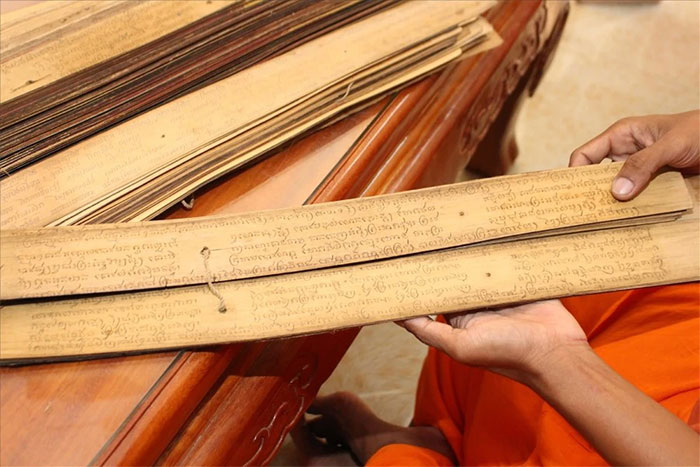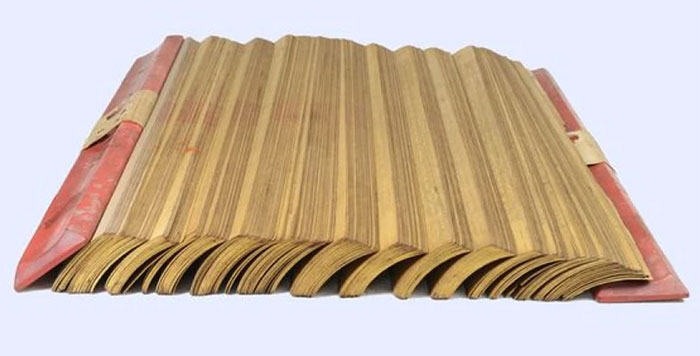The technique of writing on palm leaves by the Khmer people is a form of folk knowledge, containing a priceless treasure of human wisdom.
Over 1,000 years ago, the palm leaf scriptures – the first written heritage of Theravada Buddhism transmitted from India and Sri Lanka, initiated a historical migration across Southeast Asia.
The “Palm Paper” of the Khmer People

Writing on palm leaves.
The Khmer ethnic group has a long-established language and writing system that has gradually been refined. After Theravada Buddhism was introduced into the cultural life of the Khmer people, along with the Pali scripture system, the Pali language began to blend into the Khmer language, enriching it further.
According to the Ho Chi Minh City History Museum, since the advent of writing, the Khmer people have used various tools to preserve their knowledge, including stone tablets, palm leaves (Satra), and paper. Among these, palm leaves are the most distinctive medium.
To this day, there is no documentation revealing the exact time when palm leaves were first used as a writing material. Some of the oldest archaeological evidence of palm leaf manuscripts dates back to the 2nd century AD in India. In Southern Vietnam, the appearance of palm leaf scriptures was recorded in the mid-19th century, used in the study and teaching of monks.
According to the Ho Chi Minh City History Museum, experts classify palm leaf scriptures into four main groups: Satra Rương (story scriptures), Satra Lơ-beng (entertainment scriptures), Satra Chơ-bắp (legal and instructional scriptures), and Satra-Tes (scriptures and verses). Among these, Satra scriptures are still preserved in many Khmer temples in Southern Vietnam.
Palm leaves come from a type of tree similar to the sugar palm, called T-rang. In the past, this tree grew abundantly along the Tien River, Hau River, and the Tri Ton and Tinh Bien regions of An Giang Province, providing a rich source of leaves for making paper.
Palm leaves have good quality, with clear lettering, and are durable, making them less prone to tearing or decay. However, the challenge lies in knowing how to process and treat palm leaves correctly.
According to the experience of the Khmer people in An Giang, harvesting the leaf shoots to make books is considered a sacred act. People light incense to pray to the heavens and Buddha before cutting the leaves. First, they select healthy leaf shoots and wrap them with string to prevent the leaves from opening. The wrapped shoots continue to grow, thickening the leaves without hardening them.
After 8 to 12 months of wrapping the shoots, the leaves are harvested. Craftsmen use a piece of wood approximately 6cm x 60cm to clamp and cut them to the size of boards. After drying, they are cut into rectangular shapes, flattened, and stacked into bundles to create what is known as “palm paper.”

Palm leaf scriptures at the Ho Chi Minh City History Museum.
The Art of Inscribing on Palm Leaves
Writing on palm leaves is a meticulous task; artisans use a writing tool with a sharp metal tip called đéc-cha to carefully engrave on dried leaves. The engraving must be done evenly; if too light, the letters are unclear, and if too hard, the leaves may tear.
Thus, the engraver must be very skillful and must know the contours of the letters to avoid straying outside the margins.
According to monks, in the past, to engrave a set of palm scriptures, artisans needed to find a quiet space with someone to keep watch. They would concentrate intensely until the work was completed. Most palm leaf scriptures were created by monks, as only they could achieve a high state of meditation.
After writing, soot mixed with oil is applied to the letters, and the surface of the leaves is cleaned to make the letters stand out. Finally, holes are punched to “bind” the pages into a book with a wooden cover, resulting in a complete Satra.
Some people recount that to enhance durability and beautify the book, ancient artisans used a solution of gold powder mixed with water to coat the spine and cover, giving it a gilded appearance.
Each scripture set contains 4 to 10 volumes, with each volume having 20 to 60 palm leaves, and each leaf has 5 lines, totaling about 150 characters. Palm leaf scriptures hold significant value in terms of technique, aesthetics, and art, and they are crucial in the spiritual and religious life of the Khmer people.
It can be said that palm leaf scriptures have great value and play an important role in the lives of the Khmer people. They also serve as a record of Buddhist literature, including the Tripitaka, commentaries, and explanations of Theravada Buddhism in the Pali language and Khmer script.
Historically, palm leaf scriptures were used in teaching at Theravada Buddhist schools and during sermons at Buddhist festivals.
Due to their rich variety of forms, the craftsmanship involved, and their immense cultural value, “The Knowledge and Technique of Writing on Palm Leaves of the Khmer People” in the two districts of Tri Ton and Tinh Bien (An Giang) was included in the list of national intangible cultural heritage by the Ministry of Culture, Sports, and Tourism on January 23, 2017.
In 2021, the An Giang Provincial People’s Committee approved the project “Preserving and Promoting the Value of the Intangible Cultural Heritage of Knowledge and Technique of Writing on Palm Leaves of the Khmer People in An Giang Province until 2030.”
This project aims to protect and transmit the unique values of this heritage to future generations while calling for community participation in its preservation and promotion.
In An Giang, palm leaf scriptures are currently preserved in 30 out of 65 Khmer temples in the two districts of Tri Ton and Tinh Bien, with over 100 sets of Buddhist scriptures.
However, for many years, palm leaf scriptures have not been written anymore due to the lack of palm leaves. Additionally, the preservation process faces challenges, as the scriptures are vulnerable to the harsh effects of the environment, risking deterioration and potential loss.


















































